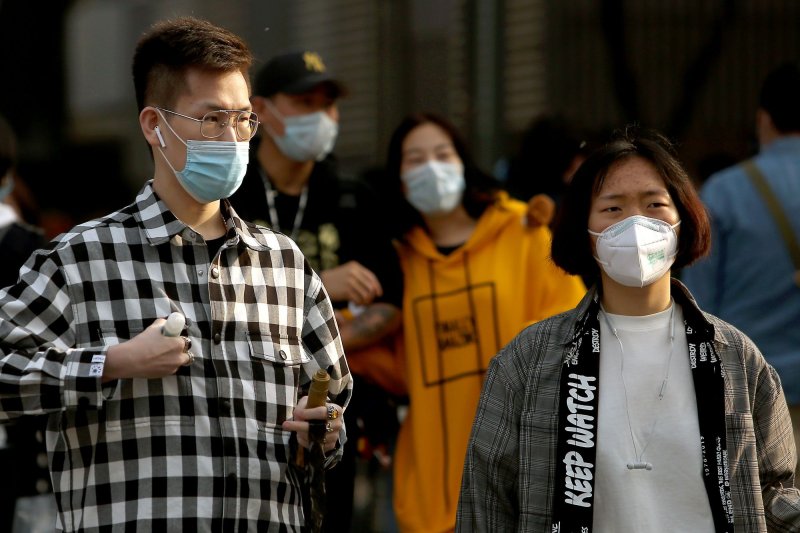Chinese people continue to wear protective face masks outside in Beijing on Thursday even though the government has declared the threat of the Covid-19 outbreak basically finished. Photo by Stephen Shaver/UPI |
License Photo
April 23 (UPI) -- Studies published this week are providing a clearer picture of the scope of the COVID-19 outbreak in China, suggesting that the virus is more contagious than thought -- but that social distancing works to limit its spread.
Without social distancing measures, each confirmed case of COVID-19 would result in roughly three "secondary" cases, researchers in Wenzhou, China, say in a study published Thursday in JAMA Network Open.
A separate analysis published Wednesday in The Lancet estimates that initial reports of case counts in Wuhan -- epicenter of the outbreak in China -- may have been off by as much as a factor of four. However, the authors of the paper note that this is a result of an evolving "case definition" disease, and not necessarily indicative of a coordinated cover-up, as some officials in the United States have suggested.
"Changing case definitions can have large effects on case incidence and reporting," Dr. Kevin S. Harrod, a professor at the University of Alabama at Birmingham whose research include infectious and chronic lung diseases, told UPI.
"To ultimately understand (how contagious a virus is), you have to know how many were infected, and the case definition would impact that."
Since the start of the outbreak in China, health officials in the country have issued seven case definitions for the virus, according to the authors of The Lancet paper. Until early February, for example, COVID-19 was only being diagnosed in the country when patients had a history of travel to Wuhan, where the disease was first identified.
Similarly, respiratory symptoms also weren't considered for diagnosis until February. And, bloodwork showing evidence of infection was added to the widely used case definition in early March.
Based on their analysis, the authors suggest that if the case definition currently in use had been there at the start of the outbreak, more than 230,000 people in Wuhan would have been diagnosed with COVID-19. At the time of their analysis, Chinese officials reported roughly 55,000 confirmed cases, and fewer than 70,000 cases have been documented in the city to date, according to figures from Johns Hopkins University.
"It's good to see the 'corrections' that this paper makes," Dr. Robert F. Garry, a professor of life sciences at Tulane University and an infectious disease expert, told UPI. "In China, the U.S. and everywhere really we are missing a lot of cases that either are not tested or are too mild or asymptomatic."
The development of symptoms was another key finding by the researchers in Wenzhou -- the Chinese city with one of the highest COVID-19 caseloads outside Wuhan, at more than 1,000 cases. They noted that time to symptom onset among patients in Wenzhou ranged from zero to 23 days, longer than the 14-day "incubation period" commonly associated with the virus.
Although two-thirds of the confirmed cases analyzed by the authors had a fever, and roughly half had a cough, 12 percent also had severe weakness or fatigue, more than the 10 percent who reported having a sore throat.
However, both Garry and Harrod agree that those who don't develop outward symptoms of COVID-19 are also driving transmission, meaning there won't be an accurate sense of how contagious the virus is until there is a more accurate assessment of how many people have actually been infected.
Based on the JAMA findings, the new coronavirus is "a bit more contagious than your typical influenza virus, but a bit more can be a difference when the spread is exponential," Garry said.















